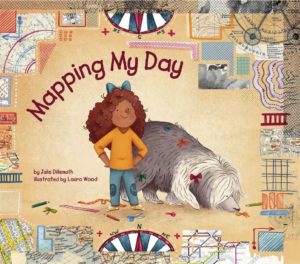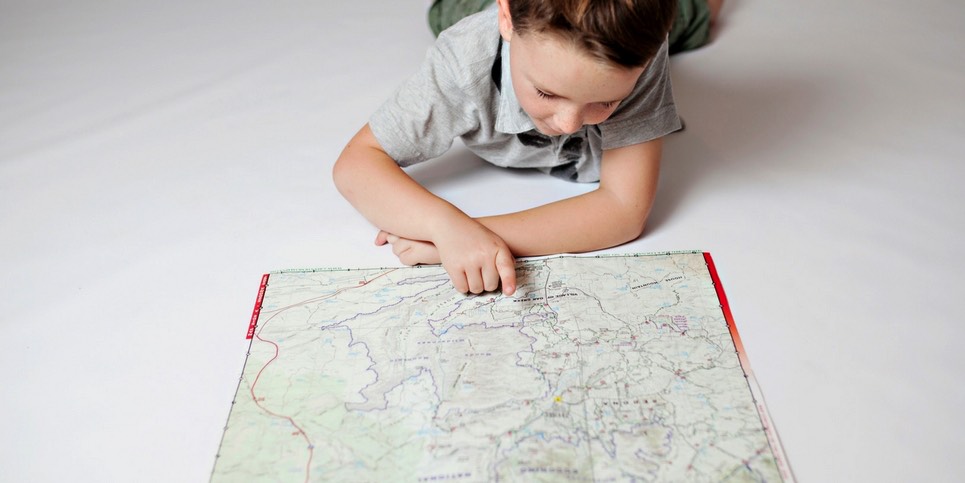Julie Dillemuth | The Children’s Book Review | March 12, 2017
Getting Young Readers Engaged and Thinking About Spatial Relationships with Maps
Most of us are familiar with maps in terms of navigating in a car or on foot or seeing the weather report on TV, and we’ve used diagrams (with varying degrees of success!) for assembling toys or furniture. But for scientists, technologists, engineers, and mathematicians, maps and diagrams are essential tools for critical thinking, understanding, and discovery. From representations of geological or biological processes to electrical circuitry to mathematical functions, drawings and images that show how things are related in physical space are important to nearly every STEM field.
Understanding spatial relationships is a key aspect of spatial thinking, which is increasingly recognized as a fundamental skill set like math or reading. Spatial thinking means how we think about and understand the world around us, and use concepts of space for problem solving. Kids learn a lot about spatial relationships in the world around them through everyday experiences, playing with building toys like blocks, exploring outside, and drawing pictures.
But when spatial relationships in the real world become symbols drawn on flat paper or screens, interpreting these representations usually requires some instruction and practice. Kids as young as preschool age can understand the concept of a map, but using one or making one has a bit of a learning curve.
Teaching kids about maps of a real and familiar environment, like a map of their room or neighborhood, is a good place to start — maps with a real-world referent are less abstract than thematic maps or data visualizations. There are several picture books out there about making maps (I’ve compiled a list of good ones here: http://juliedillemuth.com/blog/picture-books-about-maps). These books speak to the “what” and the “how,” but not so much to the “why,” or the critical thinking aspects of diagrams and maps, so important to STEM.
That’s what motivated me to write Mapping My Day; I wanted to create a picture book that would emphasize telling stories through maps, to get young readers engaged and thinking about spatial relationships. In Mapping My Day, the narrator, Flora, takes us through her day, drawing a map or diagram for everything that happens. For each scene in the story, we see a regular illustration, then we turn the page to see a map or diagram of the same thing, with some additional commentary from Flora about map vocabulary. In this way, kids can practice comparing the “real” scene with the more abstract map. And Flora draws her maps for a reason — to show us what she means with her words. In some cases it’s easier to see what she means from her map than from her description, and at times she asks the reader questions about the map. I’m hoping that readers will be inspired to incorporate spatial relationships more deliberately into their own drawings and tell stories with maps of their own.
If kids have fun with maps and diagrams from a young age, that experience will help when they need to sketch out a problem in math or science. And as they progress in school and encounter more sophisticated spatial drawings, they will already have a foundation from which to interpret maps and diagrams, learn from them, and use them to think critically.
***
 Mapping My Day
Mapping My Day
Written by Julie Dillemuth
Illustrated by Laura Wood
Publisher’s Synopsis: Flora loves drawing maps and uses them to tell us about her life! Mapping My Day introduces spatial relationships and representation: where things and places are in relation to other things. This book intends to show readers how maps can convey information, inspire children to draw their own maps, and introduce basic map concepts and vocabulary. Spatial thinking is how we use concepts of space for problem solving and is shown to be a key skill in science, technology, engineering, and math. Includes a “Note to Parents and Caregivers” with extra mapping activities.
Ages 4-8 | Publisher: Magination Press | March 13, 2017 | ISBN-13: 978-1433823336
Available Here:
About Julie Dillemuth

Photo Credit Renate von Mangoldt
Julie Dillemuth was mystified by maps until she figured out how to read them and make them, and it was a particularly difficult map that inspired her to become a spatial cognition geographer. She lives with her family and writes children’s books in Santa Barbara, California, where the west coast faces south. Visit her at her website: http://juliedillemuth.com.
Check out the fun activity pages on Julie’s website, and at: http://www.apa.org/pubs/magination/441B206.aspx?tab=1
The article How Storytelling with Maps Can Play a Surprisingly Important Role in STEM Education was written by Julie Dillemuth, author of Mapping My Day. For similar books and articles, follow along with our content tagged with Maps For Kids, Picture Book, and STEM.

